
Ciao from my little kitchen in Penne. The chilly drizzle that greeted me when I got here on May 17 has given way to blue skies, sunshine, and soft Adriatic breezes. My taste buds are back, and I’ve been taking advantage of the last days of artichoke season.
I’ll have plenty more to say about Abruzzo in the coming weeks as I scope things out for this newsletter and other projects. Right now, I’d like to stick with the subject of artichokes. I have two recipes to share, and I want to get them to you before it’s too late. Or, if it is already too late or you don’t have access to good artichokes (which is the case for me in the U.S.), I simply want to share my love for them with you.
Here’s what I wrote about artichokes in The Glorious Vegetables of Italy:
“Artichokes, a member of the thistle family that also includes sunflowers, have been cultivated in Italy since Roman times, and who knows how long they were around before that? There is a defiance about the artichoke plant, an invasive, survivalist look to its thorny leaves and leathery flower heads that makes you think that not only might it have been around since prehistoric times but also that it might still be here after the apocalypse.”
It still amazes me that something so inhospitable looking can yield such a deluxe treat. I grew up eating artichokes. The only ones my mom could find in New Jersey were the oversized globe artichokes. She would stuff the leaves generously with a garlicky breadcrumb mixture and braise the whole artichokes at length in olive oil, wine and water. Occasionally, she would add peas to the stuffing. To eat them, we would pull the leaves off and scrape off the breadcrumb stuffing with our teeth. Eventually we would get to the fuzzy choke, which we would scrape away to reveal the true prize: the artichoke bottom, which sat in a pool of sauce. It was dense and tender, herbaceous and earthy and slightly bitter. There is still, to my mind, no experience like eating a whole artichoke in this way. (The recipe is in Big Night In, btw.)
The artichokes I scooped up in Penne were much smaller—smaller than a tennis ball—and so required a different treatment. These are best trimmed of all the tough parts and then sautéed or fried or even thinly sliced and enjoyed raw, dressed with olive oil and shavings of Parmigiano cheese. It’s silly, but it still pains me to strip away all those tough outer leaves and to lop off most of the tops of these smaller artichokes because so much gets thrown away. But it’s the only way to enjoy the treasure that lies beneath.
Cleaning artichokes is a bit of a chore, but easier than you might think. I took a video of a farmer at the weekly market in Penne (whose name I later learned is Signore Nevio), demonstrating how to clean small arthichokes for preserving in oil or vinegar:
You can see that a sharp paring knife, one that fits comfortably in your hand, makes quick work of it. (There’s a recipe for oil-preserved artichokes in Preserving Italy, if you’re interested.) The process of trimming slightly larger chokes for frying or sautéing is similar, so use the video for visual guidance. Here’s how to do it:
Fill a bowl with water and squeeze in the juice of one or two lemons. Once cut, artichokes oxidize quickly and the lemon water helps prevent discoloration.
Trim off the bottom of the stem. If the stem is short, slice off the tough outer part but leave the stem attached to the artichoke. If the stem is long, cut it off and trim the tough, outer part. Drop the stem into the lemon water. Using your fingers, snap off the outer leaves of the artichoke, going all around it and continuing to remove leaves until you are left with just the tender pale center leaves. Then cut off the top 2/3 of the artichoke crosswise (where the tips of the leaves meet), leaving just the heart and bottom. Trim around the bottom to remove any tough bits.
If you’re cooking the artichokes, cut then in half or into quarters lengthwise and drop them into the water. Drain and pat dry before cooking.
To serve the artichokes raw, slice them lengthwise as thinly as possible and drop them into the acidulated water. Once all the artichokes have been trimmed and sliced, drain them and pat them dry. Arrange them on a plate, drizzle generously with olive oil and sprinkle with salt. Garnish with shavings of Parmigiano-Reggiano and serve.
Now that we’ve trimmed the artichokes, let’s get to the good part—cooking and eating them. Both of these recipes are classic, timeless, and beloved preparations. If artichoke season has come and gone where you are, you can print and save these recipes for next season.
Do you have a favorite artichoke preparation?
RECIPE: Carciofi in Padella {Pan-Sautéed Artichokes}
This is a classic preparation and one of the easiest ways to cook fresh young artichokes. The gentle sautéing softens their bitterness and turns them buttery. Serve these as a side to roast chicken, grilled lamb, or sausages. If there are any left over, stir them into a frittata. You can even toss them with pasta, using some of the starchy pasta cooking water to make a sauce and finishing with a generous grating of pecorino cheese.
Makes 4-6 side dish servings
INGREDIENTS
Juice of 1 lemon
2 1/2 pounds (1+ kg) small artichokes, about a dozen, trimmed and cut in half lengthwise (see instructions)
Extra-virgin olive oil
2 to 3 cloves garlic, sliced paper-thin
Fine salt
1/3 cup (80 ml) white wine
A small handful chopped parsley, or a mix of parsley and mint
Freshly ground black pepper (optional)
INSTRUCTIONS
1. Fill a bowl with water and squeeze in the lemon juice. Drop the artichokes into the lemon water as you clean and trim them.
2. Film a skillet with 3 to 4 tablespoons of olive oil and scatter in the sliced garlic. Cook on low for 3 to 4 minutes, until the garlic is softened but not browned. Drain the artichokes (no need to pat dry) but reserve the lemon water. Add the artichokes (and any stems) to the skillet, along with two pinches of salt, and stir to coat them with oil. Cover and cook for 3 to 4 minutes to soften the artichokes, then add the wine and turn up the heat, letting the wine bubble for a minute or so. Pour in about 1/2 cup of the reserved lemon water (or regular water if you prefer). Cover the skillet and lower the heat. Braise on low heat until the artichokes are tender. This shouldn’t take more than 10 to 15 minutes, depending on the size of the chokes. Sprinkle with parsley and mint, season with more salt, if needed, and a grinding of pepper (optional) and toss to mix everything together. Serve hot or warm.
RECIPE: Carciofi Fritti {Fried Artichokes}
I can’t think of a more inviting antipasto than a plateful of freshly fried artichokes, lightly salted. But given their relatively short season and how difficult it can be to find good artichokes if you’re not in a place that cultivates them, please know that you can use this same technique to fry a variety of other vegetables, with similarly satisfying results (see the NOTE at the end of the recipe).
Makes 8 appetizer servings
INGREDIENTS
Juice of 1 lemon
2 1/2 pounds (2+ kg) small artichokes, trimmed and quartered lengthwise; plus any trimmed stems
1 cup (125 g) unbleached all-purpose flour
1 cup (240 ml) sparkling water
1 medium or large egg
Pinch of fine salt
Sunflower oil or other vegetable oil for frying
INSTRUCTIONS
1. Fill a bowl with water and squeeze in the lemon juice. Drop the artichokes into the lemon water as you clean and trim them to prevent browning.
2. Put the flour into a bowl and gradually whisk in the water, stirring well to avoid lumps. Whisk in the egg and a pinch of salt (somewhere between 1/4 and 1/2 teaspoon). The consistency of the batter should be like cream—thick enough to coat the artichoke wedges but still pourable.
3. Pour about 1-inch (2.5 cm) depth of sunflower oil into a skillet (9-inch / 23-cm) and set it over medium-high heat. While the oil is heating, drain the artichoke wedges and pat them dry. Transfer a handful of them—about 12—to the bowl with the batter, stirring them around with a spoon or fork to coat them thoroughly. Test the oil for readiness by dropping in a tiny drop of batter; it should sizzle immediately. Or use the ‘nonna trick:’ immerse the handle end of a wooden spoon into the oil; bubbles should form around it immediately. (If using a candy or deep frying thermometer, bring the oil to 375° F (190° C.)
4. When the oil is ready, drop in the batter-coated artichokes. I use my fingers to lift them out of the batter and (carefully) drop them into the oil; you can you a fork or tongs if you prefer. Fry for 3 to 5 minutes, turning them once or twice, until they are golden. Use a skimmer or spider to transfer them to a paper-lined plate to drain. Keep battering and frying the wedges until done. Sprinkle lightly with salt and serve. These are, of course, best while hot. But they are also quite delicious warm or even at room temperature. One of those antipasti that are hard to stop popping into your mouth once you’ve taken that first bite.
NOTE: I served this with thin wedges of semi-aged pecorino Abruzzese, which is milder than pecorino Romano. Pretty much any good cheese can stand in, from mozzarella to Gorgonzola.
It’s likely you’ll have leftover batter. Rather than toss it, use it to fry other vegetables: zucchini strips, broccoli or cauliflower florets, wedges of fennel. Or just pour little puddles of batter into the hot oil to make fritters. Sprinkle with salt and enjoy hot, topped with an anchovy fillet or small piece of prosciutto.
PICTURE ITALY: Calanchi di Atri, 2023
Buona Domenica will be on hiatus next Sunday, while I’m on the road. The next newsletter will publish Sunday, June 11. And I’m working on something special for my paid subscribers. Stay tuned!
As always, thank you for reading, subscribing, and sharing.
Alla prossima,
Domenica






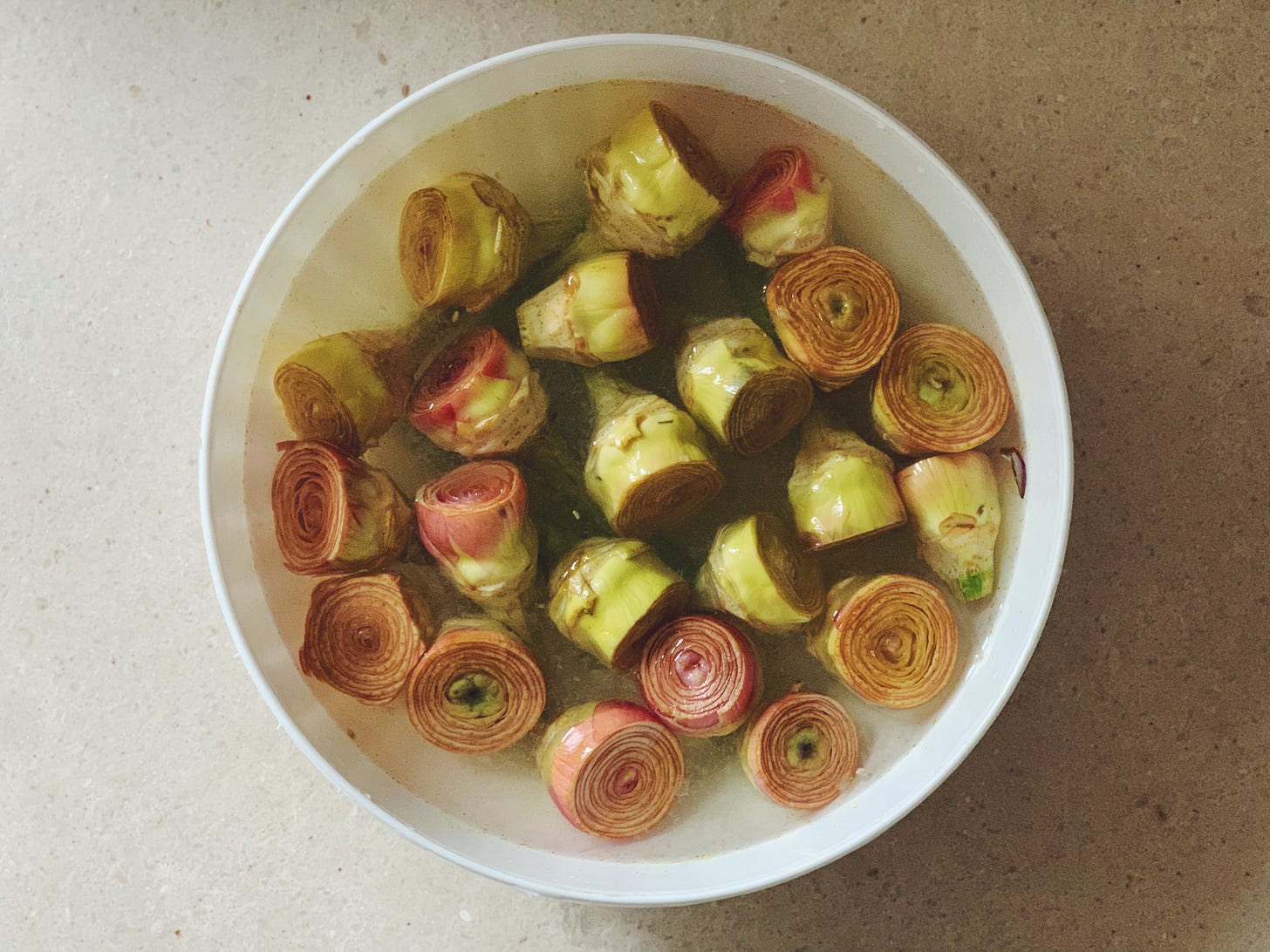
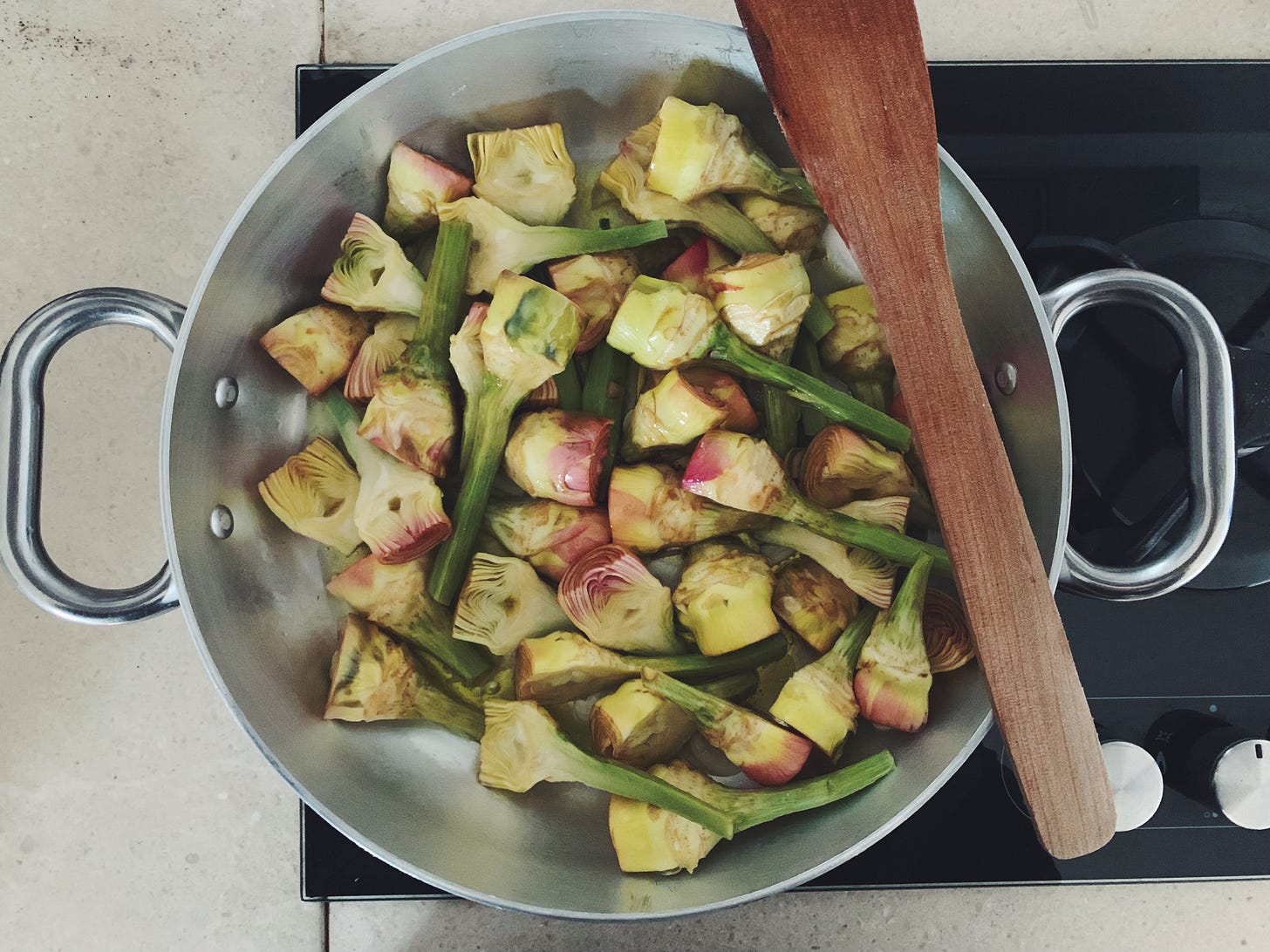
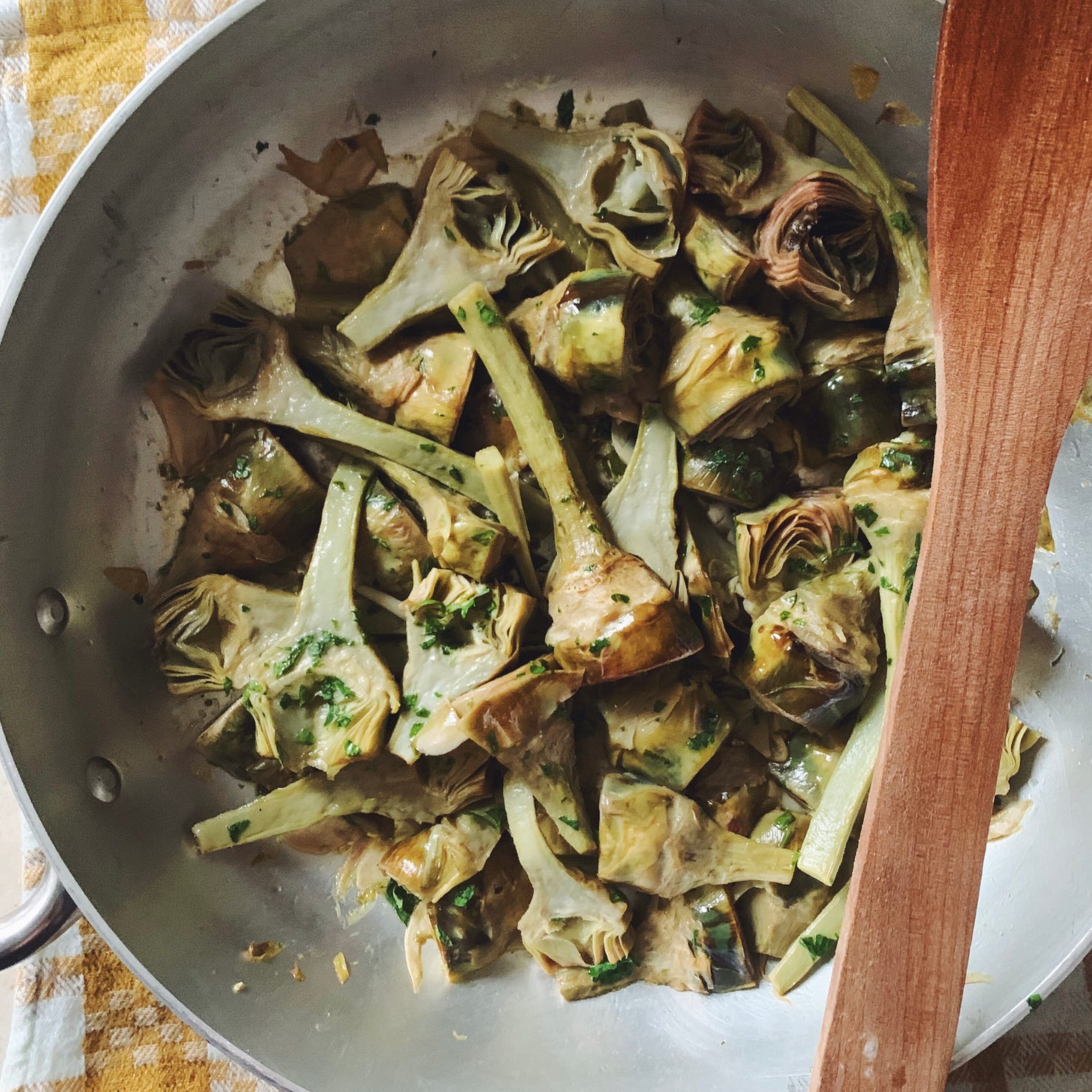
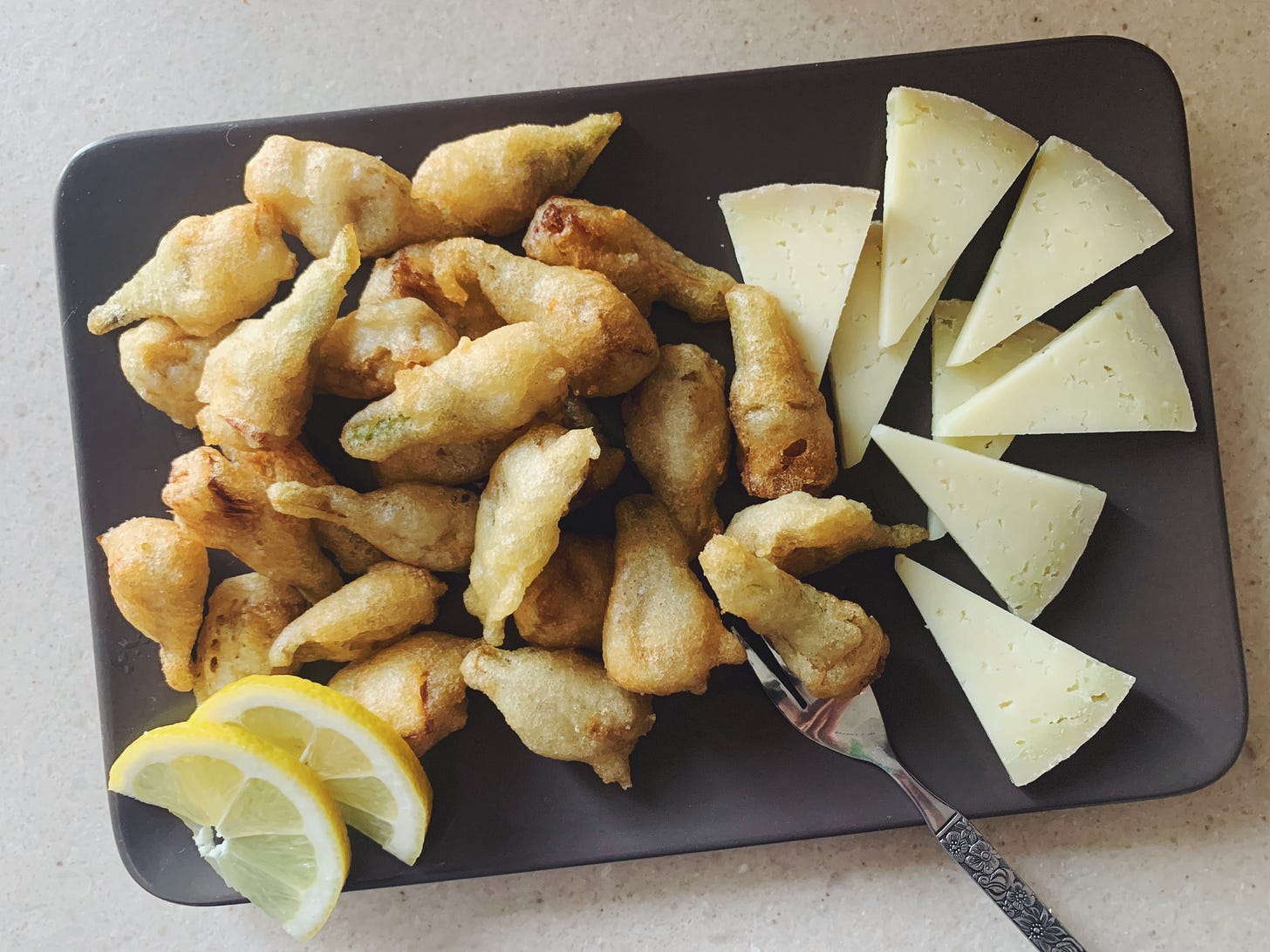
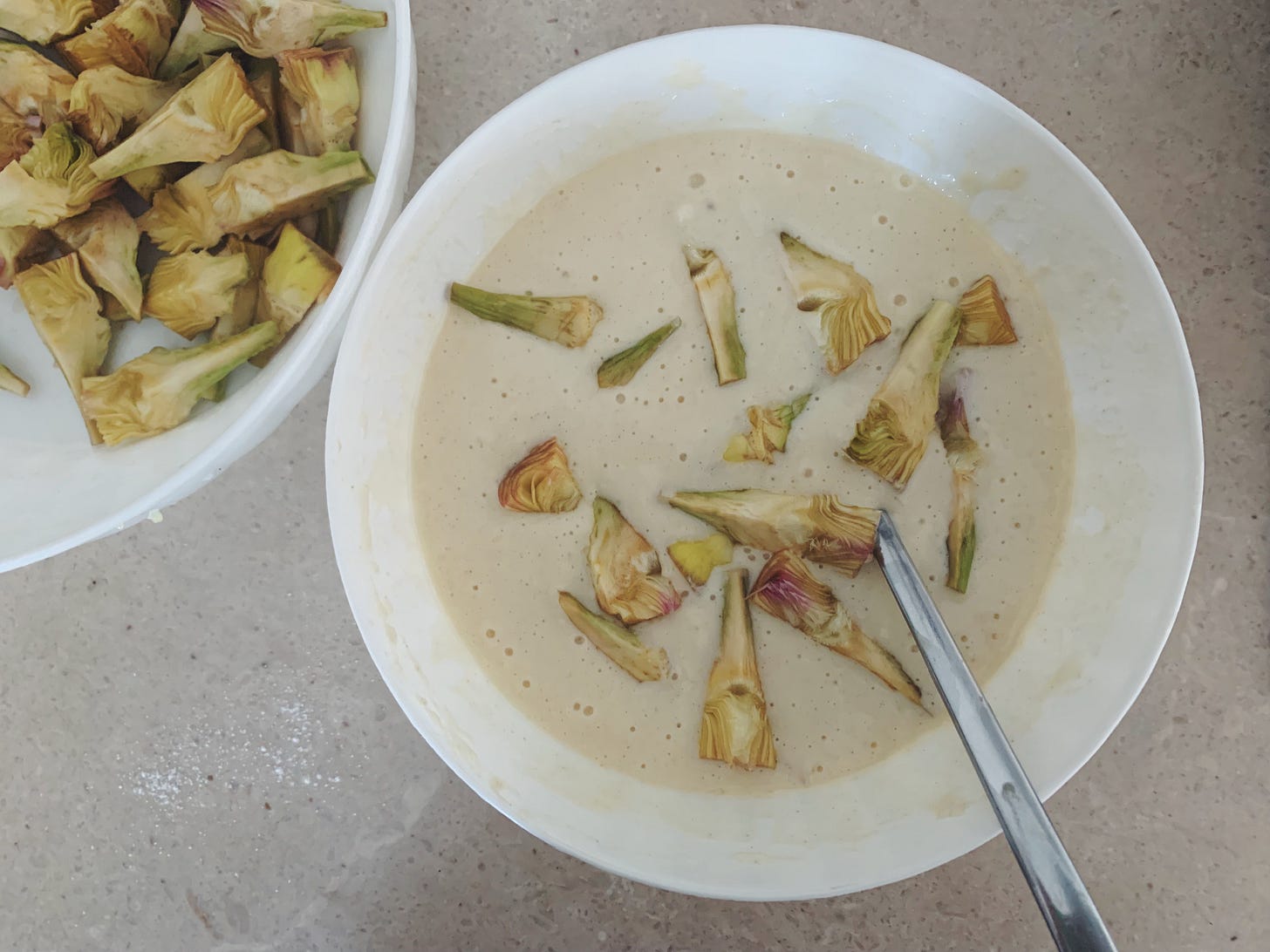
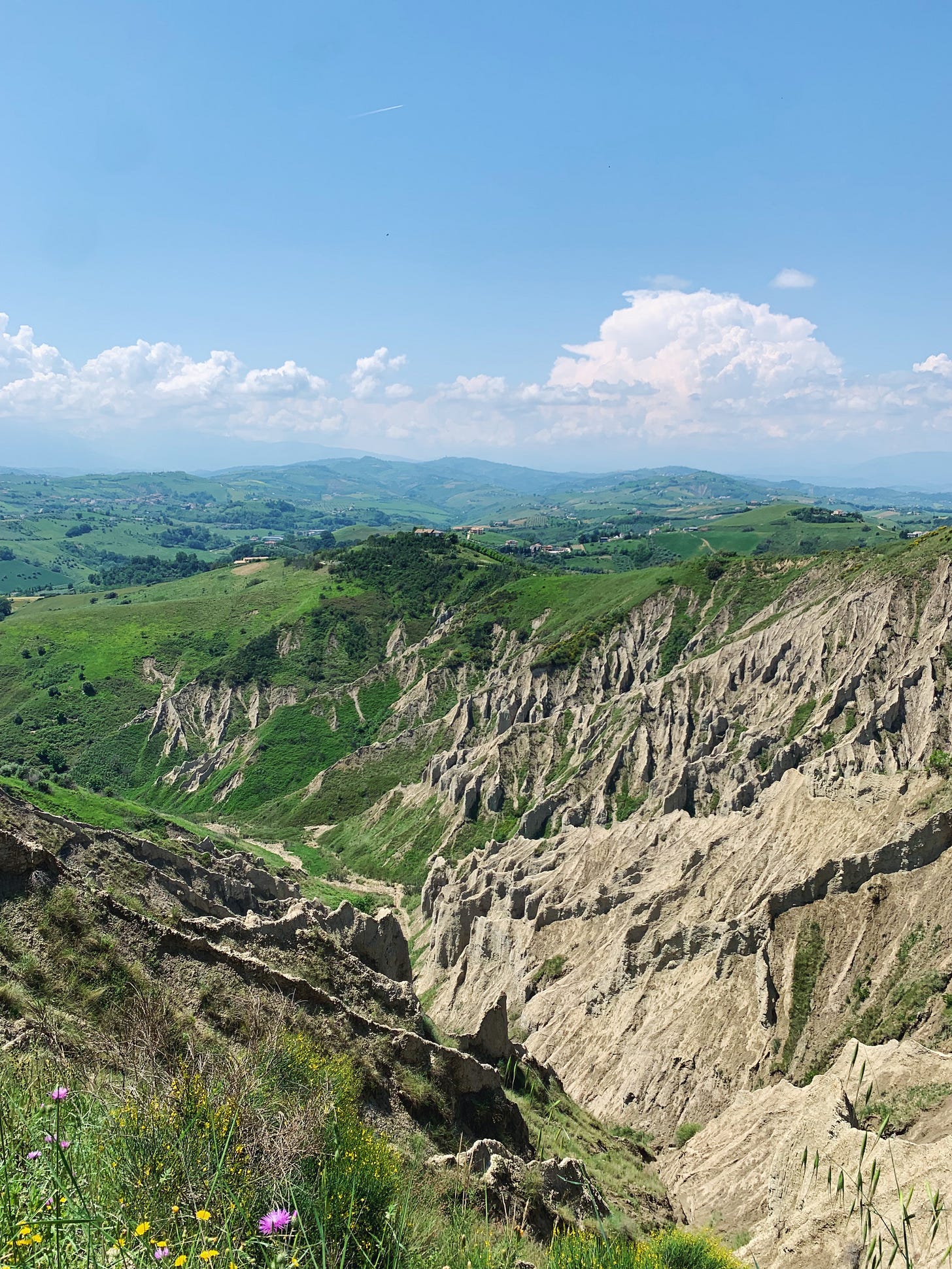
Yes, another California girl here with the same complaints, especially now that I moved to Maine!! Sigh. I’m going to Italy next artichoke season!! Thanks for the great recipes and the paring knife video! Travel safe!
This a lovely tribute to artichokes - thanks for including them in this delightfully written piece. I hope this will drive others to try artichokes - perhaps even making them a regular on the table when they are in season!